Introduction
Many of our most challenging invasive and noxious weeds are aggressive herbaceous species that are deeply rooted and highly competitive with native plants (Cal-IPC 1999). They generally tolerate a wide range of stresses, including drought, grazing, burning, and mowing. They frequently invade and establish in areas where management is difficult and effective options are limited. These areas can include sensitive locations such as wetlands, areas along bodies of water, and plant communities with rare or endangered species.
Despite the limited control options available, it is important not to refrain from controlling invasive weeds in these areas, as these areas often provide critical habitat for wildlife and serve as effective buffers to protect water quality. They are often directly linked to waterways or other vectors that aid in subsequent dispersal of weeds.
In many cases, no affordable, effective management methods exist for these herbaceous perennial weeds. As a result, infestations are often left unmanaged, and small infestations increase in size and continue to reproduce, spreading into nearby areas.
The most effective and economical management strategies for these herbaceous perennial weeds typically involve the use of herbicides. Unfortunately, the selection of herbicides registered for use in these sensitive locations is limited.
Applying herbicides directly to freshly cut stems of trees and large shrubs has been a common practice for decades (Kossuth et al. 1978, Malefyt and Macks 1985). Using this method on small, woody species and herbaceous perennials is a recently introduced management tool (Wahlers et al. 1997b). This publication describes a modified version of the cut-and-treat technique that can be used to effectively control certain perennial herbaceous species in sensitive habitats while minimizing impacts to native and desirable plant species and protecting water quality.
A variation of the cut-and-treat method, referred to as the “dip-and-clip” method, was tested on a number of infestations of diffuse knapweed (Centaurea diffusa), Dalmatian toadflax (Linaria genistifolia spp. dalmatica, Figure 1) and perennial pepperweed (Lepidium latifolium, Figure 2) in Douglas County, Nevada, and in the Lake Tahoe Basin. The method may be effective on other herbaceous invasive weed species, but no information is currently available to determine potential success.
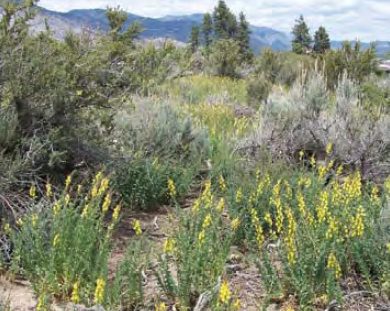
Figure 1. This test plot in Douglas County, Nevada was infested as a result of intentional planting of Dalmatian toadflax as an ornamental plant.
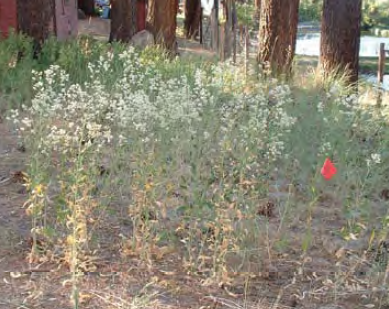
Figure 2. This perennial pepperweed infestation was growing adjacent to sensitive trout habitat at South Lake Tahoe, California, limiting herbicidal control options.
Applying the Dip-and-Clip Method
Plants should be treated at the early flowering stage when stems have bolted, but before fruiting has begun. If your plants have begun to fruit, bag and remove cut stems from the field site, as fruits can still mature and produce viable seeds. When attempting to control perennial herbaceous species, monitoring and treatment should be performed yearly until the seedbank diminishes and older plants do not resprout.
Before using any of these methods, be sure to read the label on the herbicide container carefully and thoroughly to ensure correct use in the appropriate habitat. Some of the herbicides recommended below are not approved for all locations. In wetland areas, water-labeled formulations of glyphosate such as Rodeo®1, should be used rather than similar brands of nonaquatic-labeled glyphosate (Roundup®1, etc.).
Use the concentration of herbicide recommended below (Table 1) for the plant you are trying to control, and include an appropriate surfactant, such as Activator 90, if the label recommends one. Effective rates of various herbicides tested in field trials are provided in Table 1. Telar® (chlorsulfuron) should be mixed immediately prior to use, and stored for no more than 24 hours.
Table 1. Rate of herbicides and active ingredients in the applied solutions
| Herbicide (Active Ingredient, Ai) |
Formulation1 |
Rate |
| Telar® (chlorsulfuron) |
75% AI |
.282 ounces/gallon |
| Rodeo®2 (glyphosate) |
53.8% AI |
38.1% |
| Roundup®2 (glyphosate) |
41% AI |
50% |
| Transline® (clopyralid) |
40.9% AI |
25% |
|
1There are many brands of herbicides that contain glyphosate, and the formulations may vary from those listed in this column. If the brand of herbicide being used has a different formulation than that listed in the table, adjust your rate accordingly.
2Rodeo is an aquatically labeled brand of the herbicide glyphosate that may be used in or near water according to label directions. Roundup is a terrestrially labeled brand of glyphosate that may not be used adjacent to or in water. Other brands of glyphosate will work as effectively as the two examples provided. Check the label to verify that the formulation and brand is licensed for the location being treated.
|
Follow requirements listed on the label regarding use of personal protective equipment. At a minimum, wear herbicideresistant gloves and eye protection. Mix the herbicide and surfactant solution in a suitable location away from sensitive plants or water bodies.
Mix the herbicide in a container with a mouth wide enough to accommodate the tool. We found a 32-ounce plastic or polycarbonate bottle worked well. Label the container and use it only for this purpose.
Select sharp, durable clippers that are used only for herbicide application. When selecting clippers, avoid the use of anvil- type tools, as they crush the stem upon use. This prevents the herbicide from moving down into the roots of the plant.
Once the herbicide solution has been mixed and is ready to apply, place the container on a plastic sheet or in a large bucket to contain any spilled herbicide. Dip the clipper blades into the solution with the blades in an open position so all cutting surfaces become wet (Figure 3). Hold the plant you intend to cut with the nonclipping hand, and cut the stem with the dipped clippers at the lowest point possible above the soil surface (Figure 4). Clip the stem with the flat surface of the clippers facing downward so that the bottom portion of the stem (the part connected to the root system) receives the most direct application of herbicide (Figure 5).
If you are removing the upper portion of the cut stems from the field site, place them directly into a plastic bag after cutting them. The cut portion of the upper stems will also be coated with the herbicide, so wear protective gear while bagging.
Before removing your protective equipment, carefully rinse the clipper blades over the bottle of herbicide. There will be minimal residue on the blades, so only a quick rinse will be needed. The clippers can then be dried and placed in a plastic bag until the next use. The solution remaining in the bottle can be diluted to the appropriate concentration (see label directions) and used to spray other weeds in another location. After emptying the bottle, be sure to rinse it well. Apply the rinse water to other weeds, or use to dilute the remaining solution.
Monitor the site regularly and re-treat weeds and sprouts as needed. It may take several years of repeat treatments to eliminate the population.
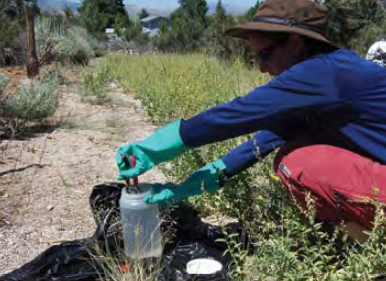
Figure 3. After donning protective gloves, carefully dip the clipper blades into the herbicide solution. Do not let the solution drip onto the ground.
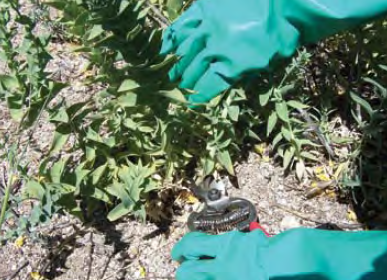
Figure 4. Clip plants as close to the soil surface as possible. Avoid touching the blades to the soil.
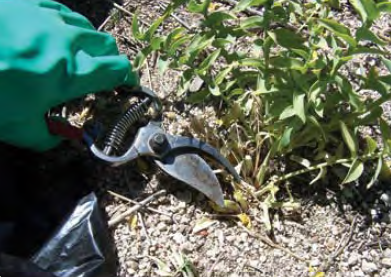
Figure 5. Hold the clippers with the flat surface facing downward to maximize the amount of herbicide applied to the cut stem.
Research Study Results
Using the dip-and-clip method, both chlorsulfuron and glyphosate were effective on Dalmatian toadflax and perennial pepperweed (Table 2). Diffuse knapweed was most effectively controlled using clopyralid, although glyphosate was also effective. We did not test this method on other species of perennial weeds.
For the spot spraying treatment, we applied Telar® on Dalamatian toadflax, Transline® on diffuse knapweed, and Rodeo®1 (glyphosate) on perennial pepperweed at the concentrations recommended on the labels. Spot spraying provided similar levels of control for diffuse knapweed and Dalmatian toadflax when compared to the dip-and-clip method, but much poorer control of perennial pepperweed. Spraying is also problematic in many sensitive locations, as adjacent plants can be damaged.
Cutting only, without herbicide application, provided poor control in all cases, and is not recommended for control of these species.
In addition to controlling the three weed species, the dip-and-clip method allowed us to conserve existing vegetation in these sensitive sites. Native species, such as monkeyflower (Mimulus bigelovii), recovered better in our treated Dalmatian toadflax sites than in our untreated control sites.
Table 2. Percent reduction in plant cover one year after treatment
| Treatment |
Diffuse Knapweed |
Dalmatian Toadflax |
Perennial Pepperweed |
| Telar® (chlorsulfuron) |
91% |
81% |
80% |
| Rodeo®1 (glyphosate) |
95% |
81% |
76% |
| Transline® (clopyralid) |
99% |
63% |
(not applied) |
| Spot spray |
97% |
82% |
45% |
| Cut only |
53% |
56% |
24% |
| 1While these are examples of formulated versions of glyphosate, many others are available and work as well as the mentioned brands. |
Conclusions
The dip-and-clip method offers land owners an alternative method for controlling small infestations of perennial weeds in sensitive locations and diverse plant communities. We recognize that this method is time and labor consuming, and is only practical for small infestations, but it can be used by groups of trained volunteers, dedicated weed workers or those who want to control weeds on their property. It is no more labor intensive than hand-pulling of small weed populations, and produces less soil disturbance, which is known to promote the germination and spread of invasive plant species. While the use of herbicides can be intimidating to some, the precision application of herbicide to targeted weed species offers promise as a method for controlling invasive weeds in sensitive sites while protecting valuable plant species and water quality.
Literature Cited
- Cal-EPPC. 1999. The Cal-EPPC List of Exotic Pest Plants of Greatest Ecological Concern in California. Cal-EPPC. San Juan Capistrano, CA.
- Kossuth, S.V., J. Young, J. Voeller, and H.A. Holt. 1978. Four season herbicide injection of hardwoods. Weed Res. 18: 161-167.
- Malefyt, J.J., and D.D. Macks. 1985. Rights of way clearing with basal and cut surface treatments. Proc. Northeast. Weed Sci.00 Soc. 39: 220.
- Wahlers, R.L., J.D. Burton, E.P. Manes and W.A. Skroch. 1997a. Physiological characteristics of a stem cut and blade delivery method of application. Weed Sci. 45: 746-749.
- Wahlers, R.L., J.D. Burton, E.P. Manes and W.A. Skroch. 1997b. A stem cut and blade delivery method of herbicide application for weed control. Weed Sci. 45: 829-832.
Acknowledgments
Brand names are provided for example purposes only. Other brands may also be licensed for use in Nevada. Information herein is offered with no discrimination. Listing a commercial product does not imply an endorsement by the authors, University of Nevada Cooperative Extension, or its personnel.
We would like to thank UC-IPM for funding this research project, and Larry Hughes and the Lake Tahoe Basin Weed Coordinating Group for assistance in locating sites for this study.
Erskine-Ogden, J., Renz, M., Donaldson, S.
2006,
A Precision Method for the Control of Perennial Herbaceous Species in Sensitive Locations,
Extension | University of Nevada, Reno, SP-06-09


